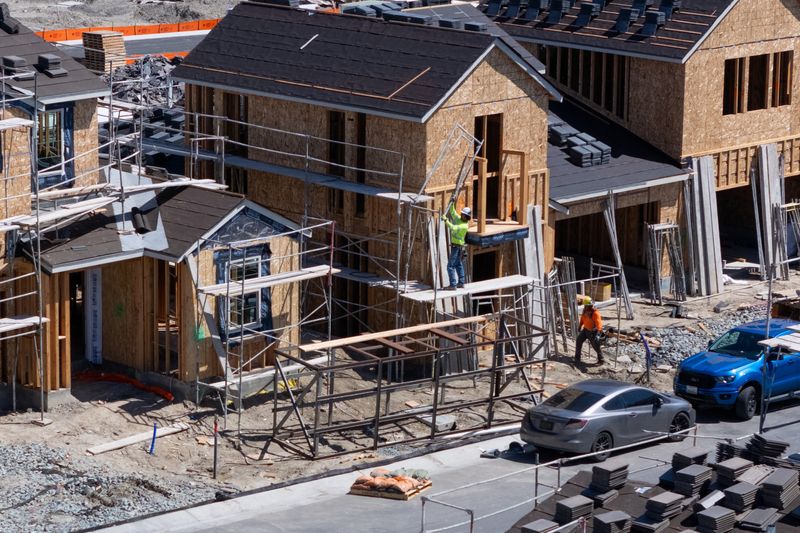
By Lucia Mutikani
WASHINGTON (Reuters) -Sales of new U.S. single-family homes fell in July following a sharp upward revision to the prior month's sales pace, and the overall trend remained consistent with a housing market struggling in an environment of high mortgage rates.
The report from the Commerce Department on Monday bolstered economists' expectations that the housing market slump could persist through the end of the year. Though mortgage rates have eased on expectations that the Federal Reserve would resume cutting interest rates in September, they continue to outpace wage growth, pushing home ownership beyond the reach of many.
"Affordability challenges and slower job growth in most industries serve as headwinds to the housing market," said Daniel Vielhaber, an economist at Nationwide. "There is little reason to expect a pick-up in sales through the end of the year due to the combination of still-high mortgage rates and a weakening labor market."
New home sales dropped 0.6% to a seasonally adjusted annualized rate of 652,000 units last month, the Commerce Department's Census Bureau said. The sales pace for June was upgraded to a rate of 656,000 units from the previously reported pace of 627,000 units.
Economists polled by Reuters had forecast new home sales, which make up about 14% of U.S. home sales, would rise to a rate of 630,000 units. Sales declined 6.6% in the Midwest and dropped 3.5% in the densely populated South. They were unchanged in the Northeast and increased 11.7% in the West.
New home sales, which are counted at the signing of a contract, are volatile on a month-to-month basis and subject to big revisions. They dropped 8.2% on a year-over-year basis in July. Government data last week showed single-family homebuilding rebounded in July though permits for future construction rose marginally.
Economists expect that residential investment, which includes homebuilding and home sales through broker commissions, to contract for a third straight quarter in the third quarter.
SEPTEMBER RATE CUT EYED
The housing market has been hardest hit by the U.S. central bank's tight monetary policy stance. Fed Chair Jerome Powell last week signaled a possible rate cut at the central bank's September 16-17 policy meeting, in a nod to rising labor market risks, but also noted inflation remained a threat.
August employment and inflation reports due to be published next month will greatly influence the rate decision. The Fed has kept its benchmark overnight interest rate in the 4.25%-4.50% range since December.
The average rate on the popular 30-year fixed-rate mortgage has dropped to around 6.58% from 7.04% in mid-January, data from mortgage finance agency Freddie Mac showed. Mortgage rates track the 10-year U.S. Treasury yield. Annual wage growth has slowed to 3.9% from 4.3% in January 2024 in tandem with easing labor market conditions.
The inventory of unsold homes on the market dropped to a still-high 499,000 units last month from 502,000 in June. New housing supply is near levels last seen in October 2007, weighing on house prices. The median new house price dropped 5.9% to $403,800 in July from a year earlier. That was the lowest house price level in eight months.
The bulk of the homes sold last month were priced under $499,000. A National Association of Home Builders survey last week showed the share of builders cutting prices to attract buyers jumped in August to the highest level since 2022.
At July's sales pace, it would take 9.2 months to clear the supply of new houses on the market, unchanged from June. The inventory of completed new homes for sale was the highest in 16 years.
"The buildup of completed new-home inventory will limit the upside for single-family housing starts in the near-term," said Nancy Vanden Houten, lead U.S. economist at Oxford Economics. "Given excess inventory, it's unlikely new home prices will increase on a sustained basis in the near term."
(Reporting by Lucia Mutikani; Editing by Paul Simao and Andrea Ricci)

 Reuters US Domestic
Reuters US Domestic
 WMBD-Radio
WMBD-Radio CNBC Television
CNBC Television Pittsburgh Magazine
Pittsburgh Magazine CNN
CNN CourierPress
CourierPress CBS News
CBS News Press of Alantic City Business
Press of Alantic City Business LiveNOW from FOX News
LiveNOW from FOX News New York Post
New York Post 101.5 KNUE
101.5 KNUE AlterNet
AlterNet The Babylon Bee
The Babylon Bee